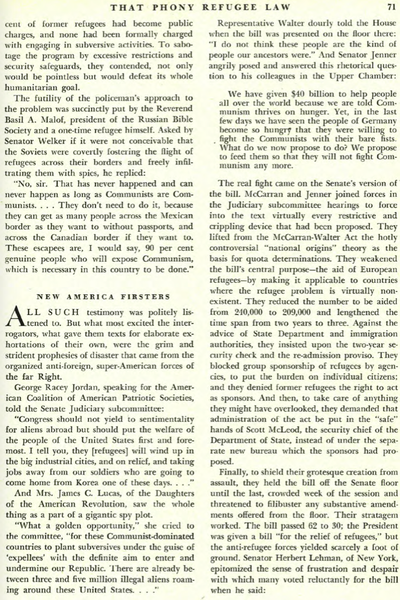Summary
Dissatisfaction with the 1952 McCarran-Walter Act quickly led to legislative action with this law which provided 214,000 visas to refugees, primarily from Europe but with 5,000 designated for the Far East. The program was designed mainly to aid those fleeing the Soviet Union, Eastern Germany and other areas of Communist expansion in Europe and was set to expire in 1956. At that time, many visas intended for Europeans were not allocated because many areas had recovered more swiftly than anticipated, while long lists of approved refugees in Asia, particularly Chinese, had not received visas because the low allocation had run out.
These unused visas were reallocated by later laws enabling immigration by more refugees from oversubscribed areas in East Asia and the Near East.
To receive a refugee visa, applicants had to verify their political history and loss of safe home, receive sponsorship from a U.S. citizen who would ensure that they would not go on welfare in the United States, pre-arrange employment in the United States, provide guarantees that they would be allowed to return to their place of abode if expelled from the United States, and pay for their costs of travel.
Source
For the relief of certain refugees, and orphans, and for other purposes.
DEFINITIONS
SEC. 2. (a) “Refugee” means any person in a country or area which is neither Communist nor Communist-dominated, who because of persecution, fear of persecution, natural calamity or military operations is out of his usual place of abode and unable to return thereto, who has not been firmly resettled, and who is in urgent need of assistance for the essentials of life or for transportation.
(b) “Escapee” means any refugee who, because of persecution or fear of persecution on account of race, religion, or political opinion, fled from the Union of Soviet Socialist Republics or other Communist, Communist-dominated or Communist-occupied area of Europe . . .
(c) “German expellee” means any refugee of German ethnic origin residing in the area of the German Federal Republic, western sector of Berlin, or in Austria who was born in and was forcibly removed from or forced to flee from Albania, Bulgaria, Czechoslovakia, Estonia, Hungary, Latvia, Lithuania, Poland, Rumania, Union of Soviet Socialist Republics, Yugoslavia . . .
SPECIAL NONQUOTA VISAS; NUMBERS
SEC. 3. There are hereby authorized to be issued two hundred five thousand special nonquota immigrant visas to aliens . . .
Dwight D. Eisenhower
160 – Statement by the President Upon Signing the Refugee Relief Act of 1953.
August 7, 1953
THIS EMERGENCY immigration legislation is, at once, a significant humanitarian act and an important contribution toward greater understanding and cooperation among the free nations of the world.
In enacting this legislation, we are giving a new chance in life to 214,000 fellow humans. This action demonstrates again America’s traditional concern for the homeless, the persecuted and the less fortunate of other lands. It is a dramatic contrast to the tragic events taking place in East Germany and in other captive nations . . .




